Psoriasis is a chronic non -communicable skin disease. According to statistics, 3. 7% of the world's population suffers from psoriasis. People call this disease "scaly lichen".
Psoriasis is not gender dependent, not contagious; most often develops at the age of 14-27 years. The disease is characterized by the appearance of red scales in the form of plaques (spots) covered with white scales. Patches (or several spots) can be on any part of the body, but are often in places with thin and dry skin: elbows, knees, lower back, scalp.
The spots have different sizes and interfere in different ways: in some patients only skin irritation is noted; in other patients, large areas of skin are involved, which is accompanied by discomfort, itching, pain, insomnia, and decreased quality of life.
Psoriasis is a chronic disease, characterized by periods of exacerbation (rash) and remission (symptoms subside).
Psoriasis often complicates pregnancy.
Causes of psoriasis
Psoriasis is a systemic process that involves not only the skin, but the whole body. The causes of psoriasis are not fully understood, but it is assumed that there are several of them: neurogenic (due to stress), hereditary, infectious, viral, mixed (skin damage with penetration of staphylococcus in combination with any of the above causes. ), Etc. In this case, cellular and humoral immunity is activated and the autoimmune process of cell damage, especially skin cells (epidermis), is triggered.
In addition to the activation of immunity, metabolism is disrupted. The disease is exacerbated by burdened offspring. As a result, cell renewal (regeneration) is accelerated 3-5 times - psoriatic plaques form on the skin.
Without timely treatment, the lesions become worse: skin spots grow, crack, purulent; broken nails, involved joints, etc.
The quality of life of psoriasis patients is 80% dependent on timely diagnosis and proper treatment.
Again, we list the factors that contribute to the onset of the disease:
- bad offspring. Scientists have identified 9 genes that determine disease progression, but their interactions are unclear. It is known that in 15% of cases, psoriasis is inherited by 1st and 2nd generation relatives;
- stress, nervous tension, depression. It has been shown that stress in 70% of cases raises the severity of psoriasis;
- hormonal imbalances;
- dysbiosis;
- metabolic disorders, drug addiction;
- colitis and parasitic infections (ringworm, lamblia, intestinal infections, etc. );
- viral infections;
- streptoderma; skin candidiasis;
- allergies.
Symptoms of psoriasis
In the early stages, psoriatic skin rashes are in the form of red plaques (spots) with flaking scales. The appearance of skin plaques is accompanied by severe itching. A denser (keratinous) layer is present under the scales.
Here are the 6 main forms of psoriasis; each has its own symptoms:
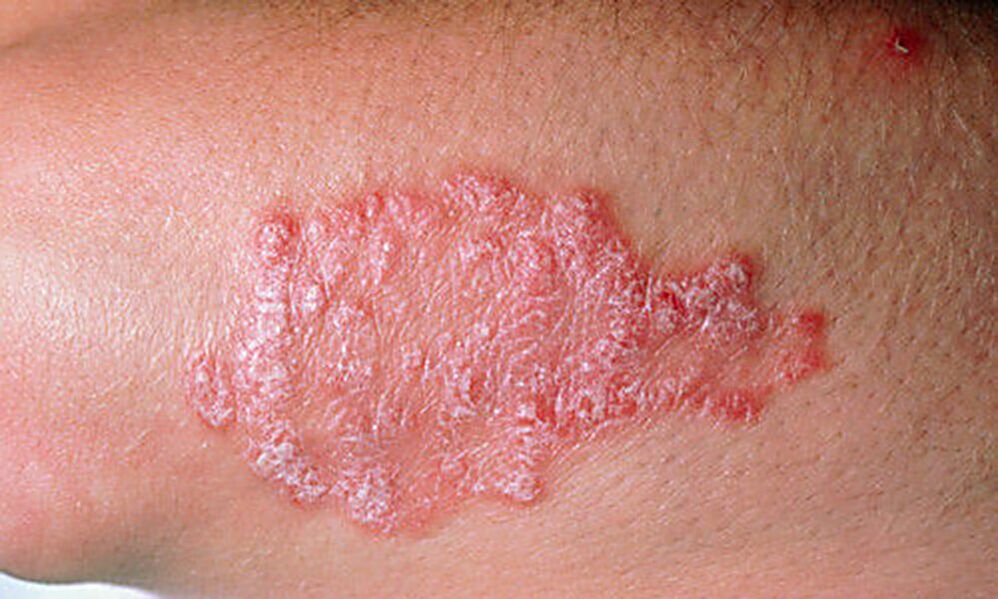
Plaque psoriasis occurs in 85% of patients. It is characterized by a dry, pink rash, raised on the skin, covered with silvery scales. The skin in the affected area often peels off; in this place, red spots remain, bleeding during trauma. In 60% of cases, the plaques merge into a large plate.
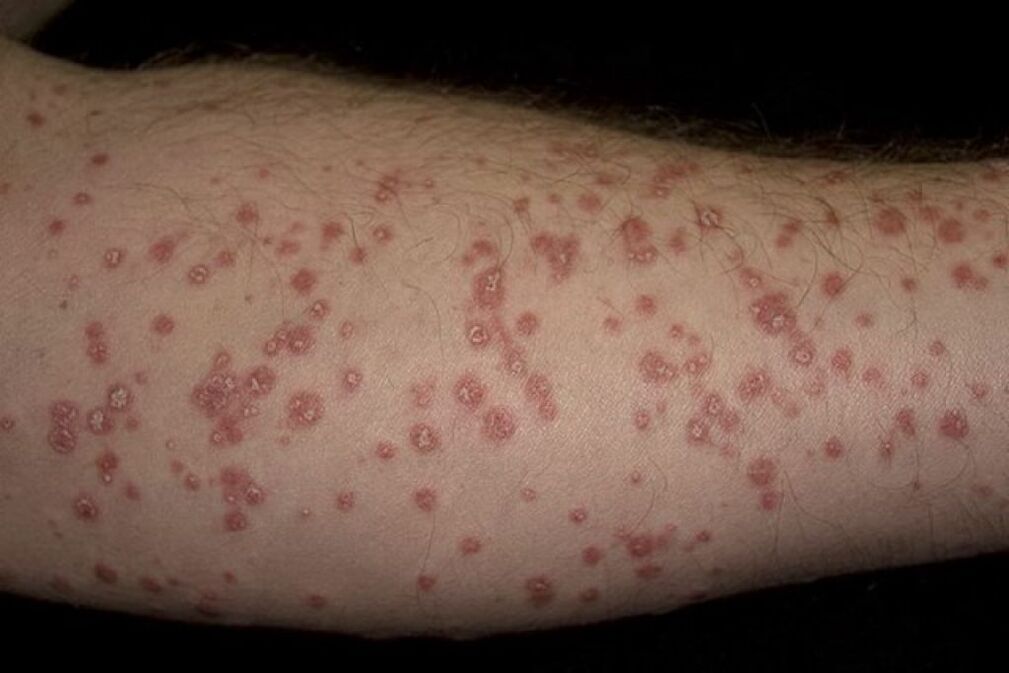
Guttate psoriasis is characterized by many small, dry lesions in the form of pink droplets that appear on the surface of the skin. The rash is localized on the thighs, legs, affecting large areas of the body. In 60% of cases, guttate psoriasis worsens after streptococcal infection.
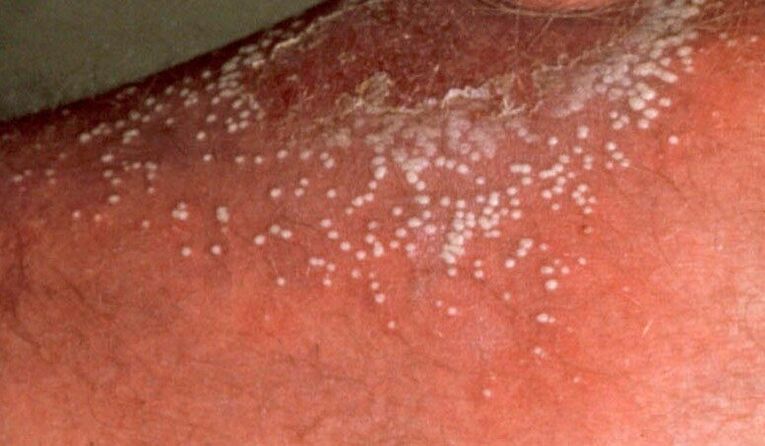
Pustular psoriasis can be identified by blisters of the skin filled with clear fluid. The blisters are surrounded by flaky skin that is red and swollen. Legs and thighs are more often affected.
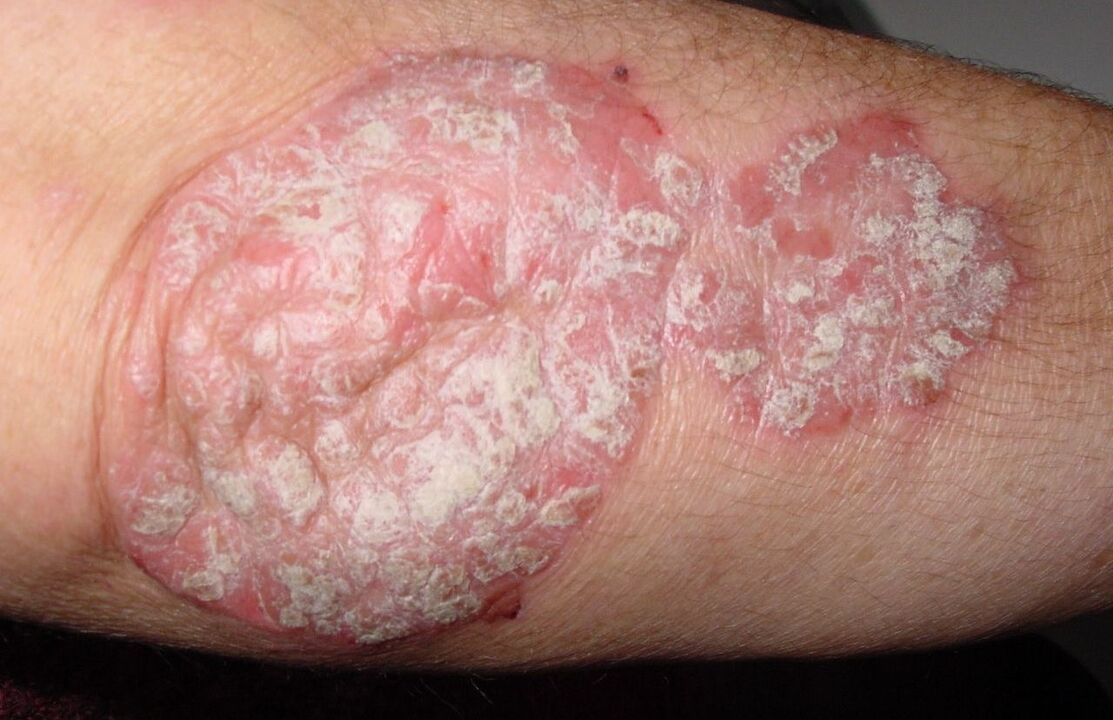
Flexor surface psoriasis manifests itself in the form of smooth, non-peeling red spots, located in the area of skin folds: the lateral surface of the thighs, armpits, and the external genital area. Due to mechanical irritation (physiological friction), the spots are injured, bleeding and purulent.
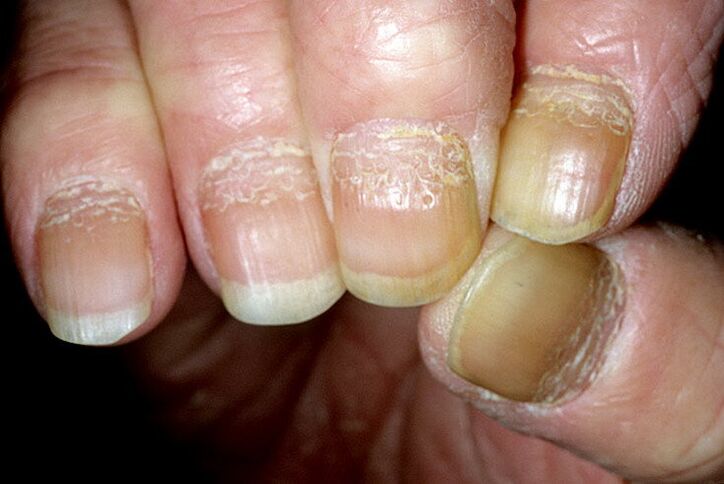
Nail psoriasis is indicated by discoloration, the appearance of spots and transverse lines on the nails. The skin around the lesion hardens. As the disease progresses, the nails peel, thicken and then dry out or fall off.
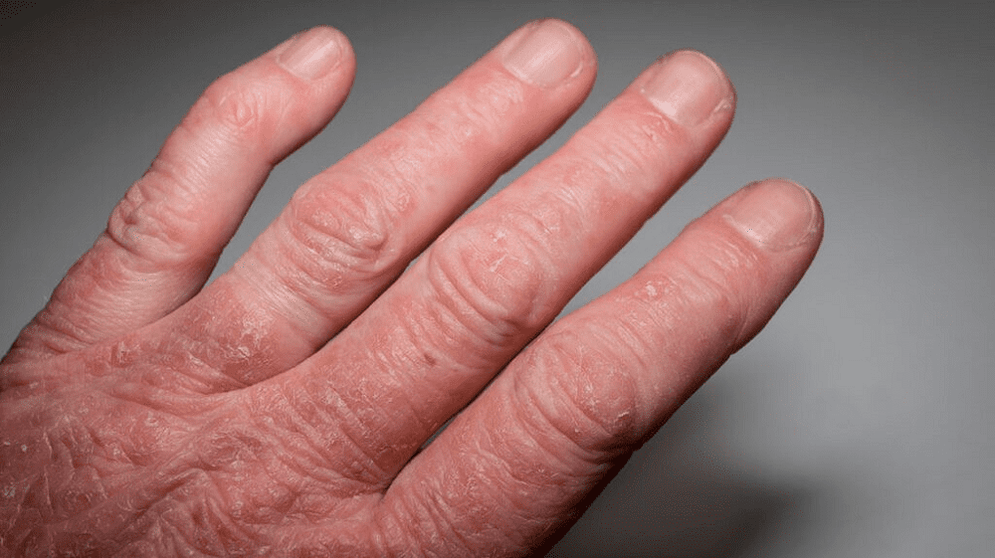
Psoriatic arthritis (15% of cases). Any joint is affected, but more often a small one - the phalanges of the hands and feet. Fingers become like sausages. Psoriasis of the joints leads to bursitis, a person's disability.
Let's talk separately about lesions on the head and elbows.
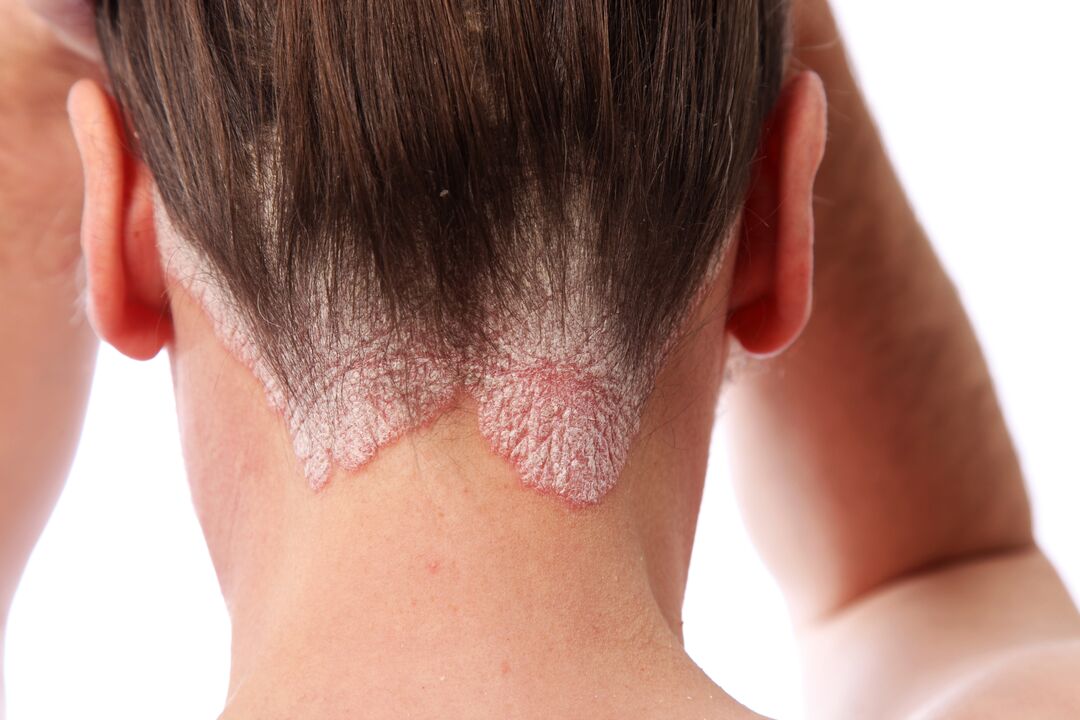
Scalp psoriasis (especially the scalp) is the most common form of the disease. It is more common at a young age. It shows itself as itchy and itchy red spots. Redness is almost always noticeable, therefore it causes emotional discomfort and leads to a person’s social isolation.
Elbow psoriasis is a disease of middle -aged people. It manifests itself in the form of a rash on the extensor surface of the elbow joint. The rash spreads outwards and merges - large plaques (plaques) are formed, covered with silvery easily falling from the scales. Along with the scales, a thin protective film is removed, exposing the bleeding surface. In 80% of cases, the spots disappear on their own, without treatment, but sometimes they thicken (become old) and persist for years, giving rise to psoriatic lesions on the elbow joint.
Diagnosis of psoriasis
Diagnosis and treatment of psoriasis is carried out by a dermatovenerologist.
Due to the characteristics of skin lesions, the diagnosis of psoriasis is simple. As additional laboratory tests, general blood tests and determination of rheumatoid factors were used. For the diagnosis of psoriatic arthritis, consultation with a rheumatologist and X-ray of the affected joint is indicated. In rare cases, a skin biopsy is performed for a differential diagnosis.
Psoriasis should be distinguished from similar skin diseases: seborrhea, lupus, etc.
Psoriasis treatment
Psoriasis is a chronic disease with periods of exacerbation (reappearance of skin rash) and remission (loss of rash). It is impossible to recover from psoriasis forever. You can prolong remission and reduce the intensity of exacerbations.
Only in 40% of cases it is possible to immediately seek effective treatment. Sometimes it takes months and years. Therefore, psoriasis is treated at home, with the exception of exacerbation and severe complications. The effectiveness of treatment is influenced by the type of psoriasis, age, concomitant disease, etc. With mild stages of psoriasis, topical preparations are prescribed: ointments and creams based on:
- glucocorticosteroids;
- zinc;
- tar;
- salicylic acid;
- vitamin D3.
In cases of severe psoriasis (25% of skin surface affected, joint damage) and ineffectiveness of local treatment, complex therapy is prescribed:
- cytostatics that inhibit epidermal cell division;
- immunomodulators that normalize immune responses;
- glucocorticosteroids, which regulate metabolic processes and reduce inflammation;
- non-steroidal anti-inflammatory drugs (to reduce itching on the skin);
- multivitamin.
Physiotherapy is prescribed: ultraviolet irradiation, cryotherapy, plasmapheresis, hirudotherapy. Folk remedies are also used: ointments based on celandine and lard, meadowsweet and petroleum jelly, beeswax and lard. To normalize immunity, they drink homemade kvass from oats, bay leaf infusion, and a decoction of dill.
Diet, especially with the exacerbation of psoriasis, plays an important role. Spicy and sweet dishes are excluded from the diet. Fast food and alcohol are prohibited. The diet should be balanced, rich in vitamins and minerals.
To avoid the severity of psoriasis, you need to improve your health, avoid stress, hypothermia and seasonal illness.
Here are simple rules to prevent psoriasis from getting worse:
- do not over -dry the skin;
- avoid prolonged exposure to the sun;
- avoid skin injuries;
- avoid stress;
- do not smoke or abuse alcohol.
Is psoriasis contagious?
There has not been a single case of psoriasis infection proven from people who became ill during household or other contact. Therefore, it is believed that psoriasis is not contagious.
Which doctor to contact
To begin timely treatment and prevent the spread of psoriasis, consult a dermatovenerologist. With the presence of psoriatic arthritis, consultation with a rheumatologist is indicated.























